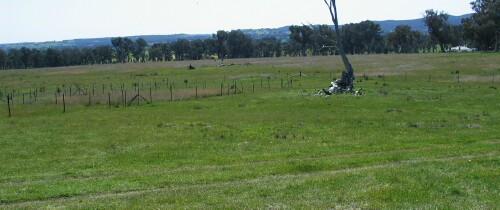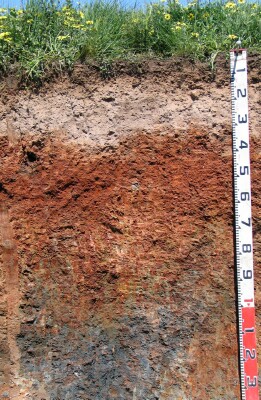NECRC1
| Location: Tarrawingee | Australian Soil Classification: Bleached-Mottled, Eutrophic, Red CHROMOSOL |
| General Landscape Description: Gently undulating rise | Site Description: CRC-PBMDS native grass trial site |
| Geology: Ordovician marine sediments (metamorphosed) adjacent to Devonian granite |
 NECRC1 landscape |
Soil Profile Morphology:
Surface Soil
| A1 | 0-10 cm | Very dark greyish brown (10YR3/2); sandy loam; weak to moderate medium polyhedral structure; many (20%) small to medium (2-15 mm) angular quartz and ferruginous sandstone; few (5-10%) patches of charcoal; pH 5.2; clear change to: |  NECRC1 profile |
| A2e | 10-30 cm | Yellowish brown (10YR5/4) conspicuously bleached (5YR7/4 dry); sandy loam; massive; many (25%) small to large pebbles (2-40 mm) (quartz ferruginous sandstone and shale); pH 5.7; sharp and wavy change to: | |
| Subsoil | |||
| B21 | 30-60 cm | Dark red (2.5YR4/6); light medium clay; strong medium to fine polyhedral structure; firm consistence (slightly moist); pH 6.2; gradual change to: | |
| B22 | 60-90 cm | Dusky red (2.5YR3/4) with strong brown (7.5YR5/6) mottles; medium heavy clay; strong medium to fine polyhedral structure; firm consistence (slightly moist); shiny-faced peds; pH 6.3; gradual change to: | |
| B/C | 90-130 cm | Dark bluish grey (5B4/1) with dark reddish brown (5YR3/4) mottles; firm consistence (slightly moist); shiny-faced peds; pH 6.1; gradual and wavy change to: | |
Key Profile Features:
- Strong texture contrast between surface (A) horizons and subsoil (B21) horizon.
Soil Profile Characteristics:
Horizon | pH | Salinity Rating | ||
Surface (A1 horizon) | Strongly Acid | Very Low | Non-Sodic | None |
Subsoil (B21 horizon) | Slightly Acid | Very Low | Non-Sodic | None |
Deeper subsoil (at 90-130 cm) | Slightly Acid | Very Low | Non-Sodic | None |

Horizon | Horizon Depth (cm) | pH (water) | pH (CaCl2) | EC 1:5 | Exchangeable Cations | |||
Ca | Mg | K | Na | |||||
meq/100g | ||||||||
A1 | 0-10 | 5.2 | 4.3 | 0.06 | 3.7 | 0.80 | 1.2 | 0.07 |
A2e | 10-30 | 5.7 | 4.8 | <0.05 | 1.3 | 0.42 | 0.21 | 0.05 |
B21 | 30-60 | 6.2 | 5.3 | <0.05 | 3.6 | 4.0 | 0.56 | 0.13 |
B22 | 60-90 | 6.3 | 5.5 | <0.05 | 2.2 | 4.3 | 0.45 | 0.18 |
B/C | 90-130 | 6.1 | 4.8 | <0.05 | 1.6 | 6.4 | 0.30 | 0.30 |
Horizon | Horizon Depth (cm) | Exchangeable Aluminium mg/kg | Exchangeable Acidity | Field Capacity pF 2.5 | Wilting Point pF 4.2 | Coarse Sand (0.2-2.0 mm) | Fine Sand (0.02-0.2 mm) | Silt (0.002-0.02 mm) | Clay (<0.002 mm) |
A1 | 0-10 | 80 | 14 | 23.9 | 9.1 | 21 | 43 | 13 | 16 |
A2e | 10-30 | <10 | 2.3 | 14.7 | 2.8 | 25 | 53 | 13 | 7 |
B21 | 30-60 | <10 | 5.5 | 26.0 | 15.9 | 12 | 28 | 9 | 51 |
B22 | 60-90 | <10 | 3.8 | 25.7 | 13.1 | 14 | 37 | 9 | 40 |
B/C | 90-130 | 25 | 3.8 |
Management Considerations:
Surface (A) Horizons
- The surface soil is strongly acid which indicates that aluminium toxicity may occur. The level of exchangeable aluminium measured in the laboratory is reasonably high (80 mg/kg) and likely to affect aluminium-sensitive species. There should be likely long-term benefits of applying lime, preferably incorporated, at this site (if the results for this pit site are representative of the paddock). Raising surface level pH will help reduce any toxic effects of aluminium. Other factors need to be considered, however, before lime is recommended (e.g. pasture species grown, method of application, local trial responses, soil surface structure and likely cost/benefit). A pH/aluminium test on a bulked sample (from across the paddock) would be appropriate to determine if lime is needed to raise pH.
- Deficiencies in molybdenum, phosphorus and potassium nay occur in strongly acid soil. Lime application may also assist in alleviating molybdenum deficiency and increase phosphorus availability.
- Upper subsoil is non-sodic and well structured (parting strongly to medium to fine polyhedral shaped peds). This indicates that there will be relatively few limitations to root and water movement into the subsoil.
Soil profile described by Mark Imhof, Will Gates and Alandi Durling, (12/10/04).


